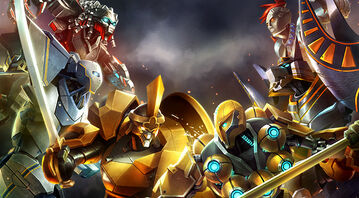The Origin of Robot Arena Combat[]
The advent of robotic and neural networking technology helped bring about a new and exciting form of entertainment: robotic gladiatorial combat.
What started out as an obscure underground sport run by shady characters and back room bets quickly burst out into the mainstream as a fully commercialized sport.
Robotic gladiatorial combat became the most popular sport in the world as nothing could compete with its intensity, showmanship, and sheer excitement.
Human Controllers[]
A Human Controller with a collection of fighting robots

While automated robots are fully capable of fighting, audiences couldn’t emotionally connect because robots lack charisma, passion, and “soul” that a human does when pushed to the limit. Human controllers were added to the sport so that robots could express enough character and personality that audiences could connect to them. Further advancements in VR neural networking technology allowed for a much deeper interface between a robot an it’s human controller. This resulted in not only allowing a human to take full control over a robot, but also allowed for a controller’s full expression of showmanship to come out through the robot into the combat arenas.
The crowds went absolutely wild.
Human Robot Controllers became worldwide celebrities with some earning salaries greater than the GDP of most small countries. They became decadent, flamboyant, disgustingly arrogant, and very expensive.
The Rise of the 3 versus 3 Tag Team Format[]
As robotic gladiatorial combat rose to world wide popularity, audiences grew bored with the same old “1 versus 1” matches. Large, chaotic matches with multiple robots fighting at the same time proved too hard for audiences to follow.
3 versus 3 tag team action[]

3 versus 3 tag team matches became the most appealing format. The strategy of knowing which robot to tag in at the right moment, the heightened sense of desperation, and increasing pressure as robots on each team get knocked out over the course of a fight drove audiences mad with excitement.
Unfortunately, the strain of managing neural connections with 3 robots at the same time proved to be too much most humans to bear. Those that didn’t suffer neurological damage and emotional break downs demanded huge pay increases over their already ridiculous salary requirements. A new solution was required if the sport was to survive.
Enter the Sentient Ai’s[]
Due to health risks and increasing costs the first Artificial Intelligence controllers were developed and tested on audiences and human controllers. It was quickly discovered that Artificial Intelligences were far superior to human controllers and provided great fights but needed charismatic personalities programmed into them. After this problem was resolved human controllers were replaced with cheaper, faster solutions. These replacements became known as Sentient AI’s. After software programmers gave them personalities as flamboyant as their human counterparts, they easily surpassed humans in popularity.
The Dominion of Sentient Ai’s[]
Sentient Ai’s

Quickly after the introduction of Sentient Ai’s the 3 versus 3 tag team format skyrocketed in popularity. The sport grew to enormous proportions bringing in trillions in profit. Sentient Ai’s evolved to be more intelligent, cunning, and their personalities became more exotic an interesting. Soon there were Sentient Ai’s representing cultures, regions, ethnicities, and even nostalgic time periods from all over the world. This was truly the dominion of Sentient Ai’s and they ruled over the most popular sport in the world for decades.
Remembering the old days[]
Yet, for all the success of the Sentient Ai’s, their character, and their cultural diversity, they still weren’t human. They still lacked the nuances that only a real human being can express. They lacked a “soul.”
Audiences have grown nostalgic for a true human controller, but technology has advanced so far that any human attempting a neural link and manage a full robot team would likely suffer catastrophic neurological failure. This would result in a permanent vegetative state.
Still, a growing rumor speaks of a human prodigy that is not only capable of controlling robots in the arenas, but capable of ending the domination of the Sentient Ai’s. Robotic experts and the Sentient Ai’s have dismissed this as an urban myth.